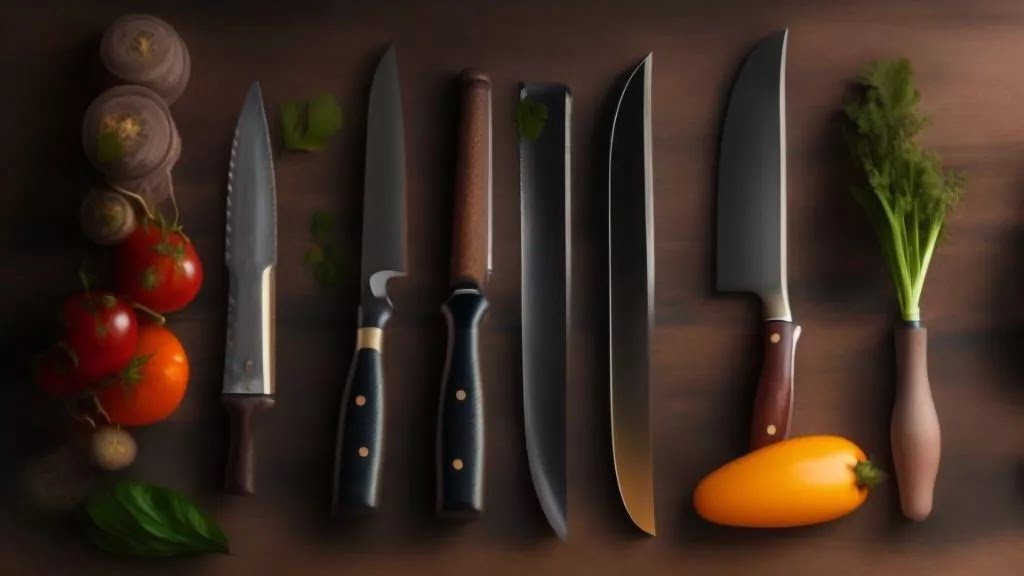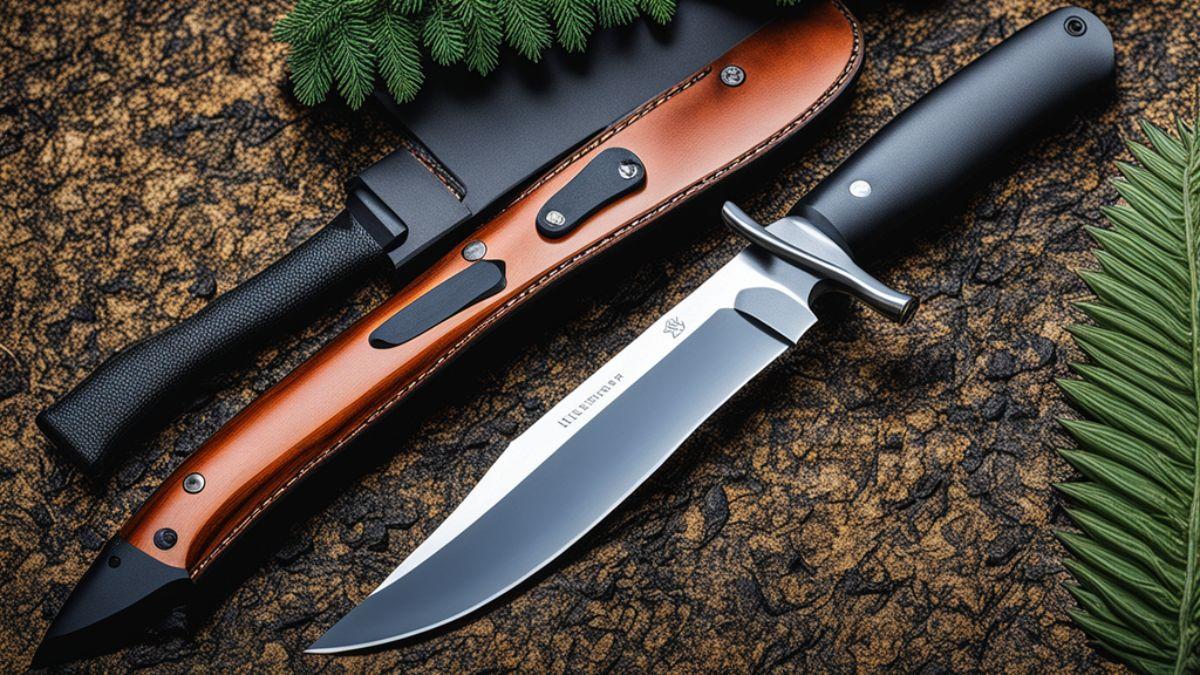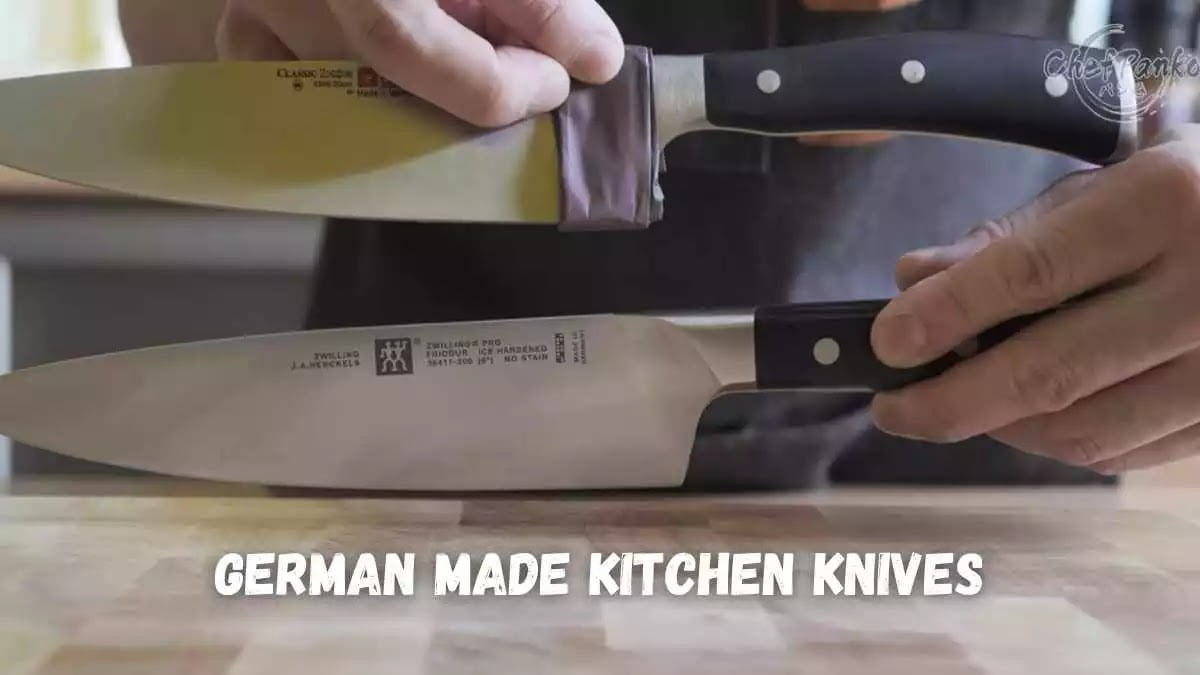
We may earn money or products from the companies mentioned in this post.
You’re looking for a new knife that can chop vegetables for all of your needs, huh? As every skilled chef is aware, having the right equipment in the kitchen can make all the difference. A knife that can cut through tomatoes like butter and remain comfortable enough to mince garlic for hours is what you need. We understand that the key is to find the ideal knife.
You’re in luck because we’ve done the legwork and found the top five veggie knives available right now. This collection includes alternatives for every budget, catering to both novices and experienced cooks. Professional-grade blades are available for those with more experience. We’ll help you locate a knife that makes chopping vegetables less of work and more of a pleasure, regardless of your budget or level of preference. Now let’s get started!
What to Look for in the Best Knife for Cutting Vegetables
When shopping for the best knife for cutting vegetables, there are a few key things to consider:
Blade Material
For cutting veggies, you want a blade that’s sharp and retains an edge. High-carbon stainless steel is a great choice. It’s hard, corrosion-resistant, and easy to sharpen. Ceramic or carbon steel blades can also work well but may require more frequent sharpening. Avoid serrated blades, which can tear delicate veggies.
Blade Shape and Size
Look for a blade with a curved shape, like a chef’s knife or santoku, and a blade length of 6 to 8 inches. Shorter blades won’t cut larger vegetables efficiently, while longer blades can be awkward to handle. A wider blade, around 2 inches at its widest point, is also useful for scooping up chopped veggies.
Handle Comfort
The handle should feel comfortable and secure in your hand. Wood, plastic, or hybrid handles often provide the best grip. An ergonomic shape that’s slightly curved will reduce hand fatigue during prolonged use.
Sharpness
A razor-sharp blade is essential for clean cuts and minimal bruising. Test the sharpness by slicing into the thinnest part of a tomato. It should cut smoothly without crushing the vegetable. Be prepared to sharpen the knife regularly to maintain performance.
Additional Features
A knife guard will protect the blade and your fingers when stored. A bolster between the blade and handle adds weight for easier slicing. Some knives also have safety features like finger guards. Look for knives that are well-balanced, durable, and dishwasher-safe for easy maintenance.
With the right knife that checks off these points, you’ll be chopping through veggies efficiently and comfortably in no time. Happy slicing!
Our Top 5 Picks for the Best Knives for Cutting Vegetables
When it comes to cutting veggies, you need a knife that’s up to the task. We reviewed some of the top-rated knives on the market to find the perfect one for you. Whether you’re dicing onions or slicing tomatoes, these knives will make quick work of all your vegetable prep.
Our Top Pick: Victorinox Fibrox Pro Chef’s Knife
For most home cooks, the Victorinox Fibrox Pro 8-inch chef’s knife is ideal. It’s affordable, ergonomic, and can handle nearly any vegetable with ease. The high-carbon stainless steel blade stays sharp and is resistant to stains, plus the handle is slip-resistant for safety. For under $50, you really can’t beat the value and performance.
Wusthof Classic Ikon 8-Inch Cook’s Knife
If you’re looking for a high-end German knife, the Wusthof Classic Ikon is a fantastic choice. The full tang, forged blade is precision-edged and tapered for effortless slicing. The ergonomic handle provides comfort and control. While pricey, the Wusthof is a kitchen workhorse that will last a lifetime.
Global G-2 Classic 8-Inch Chef’s Knife
The Global G-2 is an iconic Japanese-style knife featuring a stainless steel blade and handle. It’s well-balanced, razor-sharp, and stunning to look at. The Global cuts like a dream and is a favorite of many professional chefs. However, it requires frequent sharpening and may feel too lightweight for some. Still, for many cooks, its performance outweighs these potential downsides.
Dalstrong Gladiator Series 8″ Chef Knife
The Dalstrong Gladiator is a powerhouse knife that slices through tough vegetables with ease. It has a high-carbon German steel blade, a full tang, and a sturdy handle. For quality, the Dalstrong is very affordable. Some users find the heavier weight takes getting used to, but if you’re looking for a beast of a knife to conquer even the hardest veggies, the Gladiator delivers.
Zwilling J.A. Henckels Twin Signature 7-Inch Santoku Knife
If you prefer the precision of a Japanese santoku knife, the Zwilling J.A. Henckels Twin Signature 7-inch santoku is an excellent choice. It has a high-carbon stainless steel blade, a comfortable handle, and is very sharp right out of the box. The shorter blade and curved tip make it ideal for controlled chopping and slicing. An all-around fantastic knife for most cutting tasks.
1 Chef’s Knife: The Classic All-Purpose Vegetable Knife
When it comes to cutting veggies, nothing beats a classic chef’s knife. This versatile blade is designed to handle almost any cutting task in the kitchen. If you only have space in your budget for one high-quality knife, make it a chef’s knife.
A good chef’s knife typically has an 8-inch blade that’s slightly curved to make slicing easier. The weight should feel balanced and comfortable in your hand. High-carbon stainless steel blades hold an edge well and are resistant to stains. Some well-known brands are Wüsthof, Henckels, and Global.
With a chef’s knife, you can dice onions, slice zucchini, cube potatoes, and mince garlic. The curved shape works with the natural curves of most vegetables. Use a pinch grip with your thumb and forefinger on the base of the blade for maximum control. Always cut on a stable cutting board.
For beginners, start with basic cuts like slicing carrots, cutting broccoli into florets, and dicing bell peppers. As you get more comfortable, try mincing shallots or slicing radishes paper thin. With practice, you’ll be jumping like a pro in no time!
A chef’s knife requires frequent sharpening to keep its edge. You can use an electric sharpener, a whetstone, or have it professionally sharpened a few times a year. A sharp knife is a safe knife – it glides through veggies without slipping.
When not in use, store your chef’s knife in a knife block, on a magnetic rack, or in a sheath. Never just throw it in a drawer where the blade can get damaged or you can cut yourself reaching for it.
If you want an all-purpose knife to tackle any cutting task, you can’t go wrong with a classic chef’s knife. With a balanced, high-quality blade, you’ll be slicing and dicing veggies for years to come. Add a paring knife for more intricate work, and you’ll have a perfect knife duo for any kitchen.
2 Santoku Knife: A Japanese-Style Vegetable Slicer
The #2 Santoku knife is a Japanese-style knife perfect for slicing and dicing vegetables. Santoku means “three virtues” in Japanese, referring to its ability to handle meat, fish, and vegetables. This knife features a shorter blade and rounded tip, making it ideal for chopping on a cutting board.
The Santoku knife blade is typically between 5 and 8 inches long, allowing for controlled and precise cuts. The blade is made of high-carbon stainless steel that holds an edge well and requires occasional sharpening. A Granton edge with hollowed-out dimples helps prevent food from sticking to the blade. The shorter blade and rounded tip also make this a very safe and easy knife to maneuver.
This knife works wonders on vegetables. Its blade glides through tomatoes, cuts cabbage into perfect shreds, and chops carrots into evenly sized sticks. The slight curvature of the blade allows you to rock the knife using a gentle slicing motion. The dimples along the blade edge help release cut pieces from the blade.
Pros
*Shorter blade for controlled, precise cuts
*The rounded tip is very safe to use
*Holds an edge well but is still easy to sharpen
*Dimples prevent food from sticking to the blade
*Perfect for slicing, dicing, and chopping vegetables
Cons
*May be too short for some cutting tasks
*Requires frequent sharpening due to softer steel
If you want an easy-to-use knife that makes quick work of prepping vegetables, the Santoku knife is an excellent choice. For under $50, you can find a high-quality Santoku knife that should last for many years with proper care and maintenance. Add this classic Japanese knife to your kitchen collection, and you’ll soon be chopping like a professional chef.
3 Nakiri Knife: Ideal for Chopping Veggies
The Nakiri knife is ideal for chopping vegetables. It’s designed specifically for cutting produce and excels at slicing, dicing, and mincing veggies.
Ultra-Sharp Blade
The Nakiri knife features an ultra-sharp blade that makes quick work of even the toughest vegetables. The blade is typically 6 to 7 inches long and cuts all the way to the tip. It’s shaped like a small cleaver with a straight edge and square spine. The shape and sharpness allow you to chop with speed and precision. You’ll breeze through piles of carrots, celery, potatoes, and cabbage.
Lightweight and Comfortable
Even with its sharp blade, the Nakiri knife feels lightweight and comfortable in your hand. The balance point is centered, so it’s not handle-heavy. The blade is thin but durable, so it cuts efficiently without feeling clunky. The slim, rectangular handle also provides a secure, ergonomic grip. These features minimize hand fatigue, even when chopping large amounts of veggies.
Versatile and Multi-Purpose
While specialized for cutting produce, the Nakiri knife is versatile and multi-purpose. In addition to slicing, dicing, and mincing, you can also use it for:
- Chopping herbs
- Crushing garlic
- Hulling strawberries
- Peeling vegetables
Its sharp edge and pointed tip work for a variety of small tasks. The Nakiri knife is ideal for any recipe that calls for fresh-cut veggies, from stir fries and salads to soups and stews.
Easy to Sharpen
The Nakiri knife is made of high-carbon stainless steel that holds an edge well but is also easy to sharpen when needed. You can use an electric sharpener, a whetstone, or have it professionally sharpened. With regular honing and occasional sharpening, you’ll keep the blade in peak condition so it cuts like new.
For cutting up fruits and vegetables, the Nakiri knife is a perfect choice. It’s the ideal tool for any home cook or professional chef. With its ultra-sharp blade, comfortable design, and versatile functionality, the Nakiri knife will make food prep fast, easy, and enjoyable. Your veggies won’t know what hit them!
4 Serrated Utility Knife: Great for Tomatoes and Other Skinned Veggies
A serrated utility knife is ideal for cutting tomatoes, cucumbers, and other vegetables with slippery skins. The teeth on the blade allow it to grip the skin without squishing the inside. This is our #4 pick for the best knife for cutting veggies.
Versatile and Effective
A good serrated utility knife can handle many kitchen tasks. In addition to slicing tomatoes and cucumbers, it works great for cutting bread, citrus, and even small melons. The pointed tip allows you to pierce into hard vegetables and fruits. For many home cooks, a serrated utility knife is one of the most useful knives to have in your kitchen.
Look for High Carbon Stainless Steel
When choosing a serrated utility knife, look for one made of high-carbon stainless steel, which holds an edge well and resists stains. Brands like Victorinox, Mercer, and Wüsthof make excellent serrated utility knives using high-quality steel. Avoid very cheap knives, which won’t hold up to frequent use and require constant sharpening.
Easy to Maintain
The good news is serrated utility knives do not require frequent sharpening. The teeth on the blade will stay sharp through many uses. However, the edge can dull over time with heavy use. You’ll need to use an electric sharpener or have the knife professionally sharpened. In between sharpenings, hone the blade with a honing steel to keep the edge aligned.
A Size for Every Task
Serrated utility knives typically come in a range of sizes from about 5 to 10 inches in length. A 6- to 8-inch knife is versatile and suitable for most home cooking needs. Smaller knives are more maneuverable for tasks like cutting citrus, while larger knives are better for slicing bread, melons, and larger produce. For safety, choose a size you can handle comfortably and confidently.
A quality serrated utility knife is a must-have for any home cook. Keep one on hand to tackle all your slicing and dicing needs with ease and efficiency. With the proper care, a good serrated knife should last for many years of happy cooking!
5 Paring Knife: For Precise Cuts and Peeling
A paring knife is a must-have for any home cook. This versatile little knife allows you to do delicate tasks like peeling, slicing, and dicing vegetables with precision. At around 3 to 4 inches in length, paring knives give you great control and maneuverability for precise cuts.
When looking for a paring knife, consider the following:
- Blade material: For the best paring knife, look for a high-carbon stainless steel blade. This holds an edge well but is also rust-resistant. Ceramic or carbon steel blades require more maintenance but can be very sharp.
- Comfortable handle: Look for a knife with an ergonomic handle that feels good in your hand. Wood, plastic, or synthetic handles provide a comfortable, non-slip grip.
- Sharpness: A sharp paring knife makes cutting and peeling so much easier. Look for a knife that comes razor sharp out of the box, or invest in a whetstone or electric sharpener to keep the edge fine.
- Versatility: A paring knife can do more than just peel. Look for a blade with a pointed tip for slicing, dicing, and mincing vegetables like garlic, shallots, and chilies. A spear point or sheep’s foot blade will also work well for most tasks.
- Price: You can find a quality paring knife for between $10 and $30. Victorinox, Mercer, and Dexter-Russell all make excellent, affordable paring knives that will last for many years.
A good paring knife is a kitchen essential and the perfect companion for any vegetable preparation. Keep it sharp, handle it carefully, and it will serve you well for many homemade meals to come. For precise, delicate cuts, you can’t beat a quality paring knife.
Knife Care Tips to Keep Your Vegetable Knife Sharp
To keep your vegetable knife in tip-top shape and slicing safely, follow these care tips:
Hand Wash and Dry
Hand wash your knife after each use and dry it immediately to prevent rusting. Don’t put it in the dishwasher where it can get banged up and dull the blade. Gently wash the blade with a soft sponge or nylon scrubber. Rinse and pat dry with a towel, then let air dry completely before storing.
Honing Rod
Use a honing rod to realign the edge of the blade and keep it sharp. Slide the blade along the rod using even pressure, pulling the blade towards you at a 15-degree angle. Do 5–10 passes on each side of the blade. Honing rods do not actually sharpen the blade, they just straighten the edge.
Sharpening Stone
Once honing is no longer effective, it’s time to sharpen your knife. Use a whetstone with coarse and fine grit. Lubricate the stone with oil and hold the knife at a 15-degree angle, sliding the blade along the stone using even pressure. Do 10–15 passes on each side, checking your progress with each stroke. Rinse and wipe the blade to check for a burr, which indicates you’ve sharpened one side enough. Repeat on the other side until you feel a burr. Finish with 5–10 passes on the fine-grit side of the stone.
Storage
Store your knife in a wooden block, sheath or on a magnetic rack. Don’t just throw it in a drawer where it can get dull, dirty or cause injury. Keep it in a spot that’s within easy reach of where you do most of your chopping.
Cutting Board
Always use a cutting board, never cut directly on countertops. A wooden or soft plastic board is best for knives. Hard boards can dull the blade. Replace cutting boards that show deep grooves, which are hard to clean and can harbor bacteria.
Following these best practices will keep your vegetable knife slicing safely and like new. With regular care and maintenance, a high-quality knife can last a lifetime. Keep your knife skills sharp and your fingers intact by caring for your tools properly!
Conclusion
So there you have it, a rundown of some of the best knives for cutting vegetables out there. No matter your cooking skill level or budget, you should now feel confident finding an option that will slice and dice your veggies with ease. Any of these knives would make a great addition to your kitchen tools and help you create healthy and delicious meals. What are you waiting for? Pick out your new favorite knife and get cooking—your taste buds will thank you!















